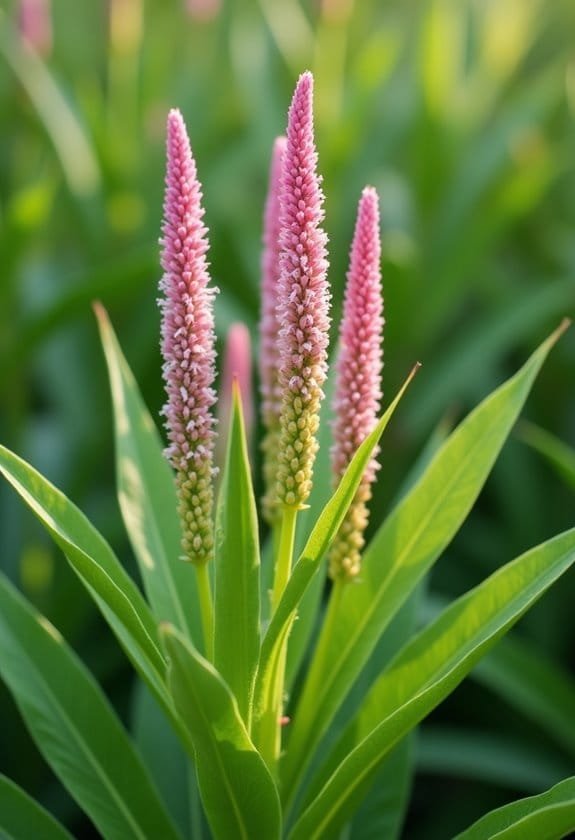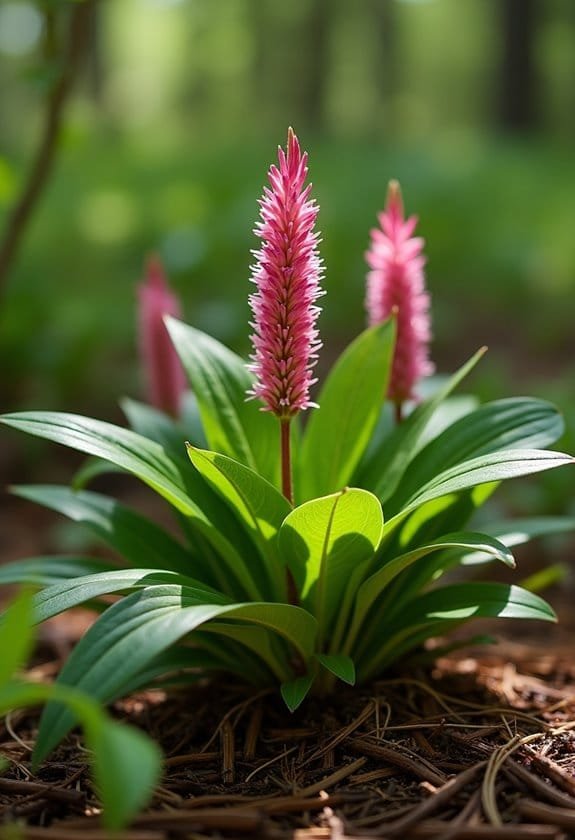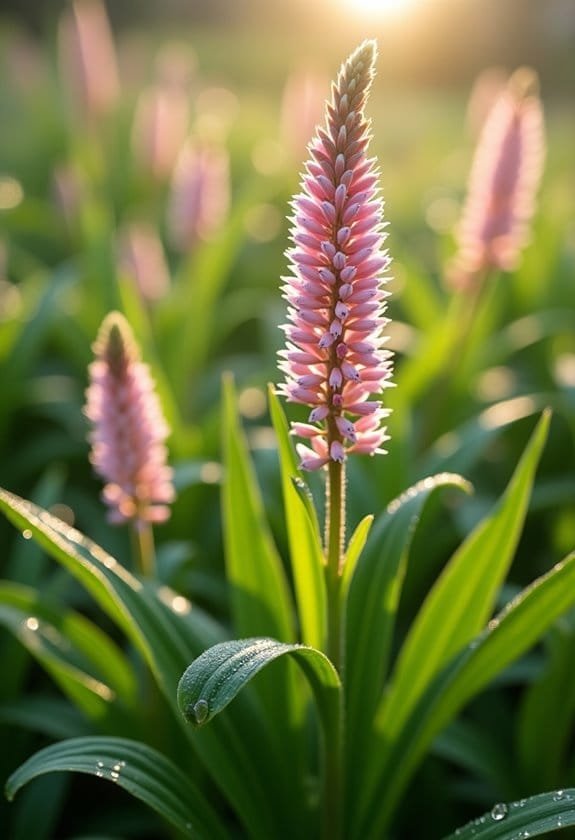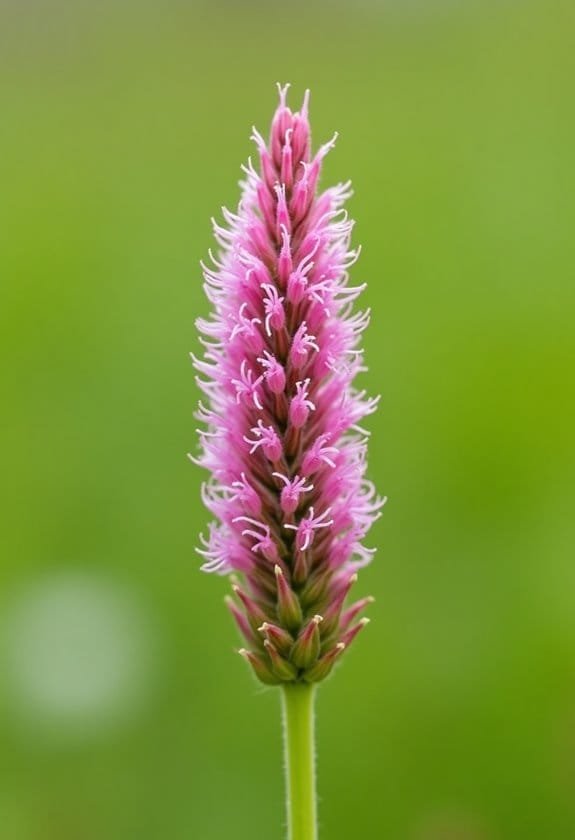Persicaria bistorta, commonly known as bistort or snakeroot, is a hardy herbaceous perennial that displays striking pink flower spikes from late spring through autumn. The plant reaches heights of 20-80 cm and spreads up to 90 cm, forming substantial clumps in damp meadows and gardens. Its robust vertical growth features long-oval basal leaves that evolve to smaller triangular foliage upward, while its thick rootstock provides strong anchoring. Bistort's dense, cylindrical flower spikes serve as natural magnets for pollinators, particularly bees and butterflies, making it an ecological powerhouse. This versatile plant's rich history extends beyond its ornamental value, offering both medicinal properties and environmental benefits worth exploring.
Main Points
- Persicaria bistorta is a hardy perennial plant growing 20-80cm tall with distinctive pink flower spikes blooming from late spring to autumn.
- The plant produces cylindrical, bottlebrush-like flower spikes measuring 4-6 inches that attract bees and butterflies during its April-August blooming period.
- Common bistort thrives in rich, moist soils with acidic to neutral pH and adapts well to both full sun and partial shade.
- The plant requires regular deadheading, consistent moisture, and division every 3-4 years to maintain healthy growth and prevent overcrowding.
- Also known as Snake-root and Pudding Dock, this plant offers medicinal properties through tannic acids and helps stabilize soil in bog gardens.
Introduction

Persicaria bistorta, commonly known as common bistort or snake-root, stands as a remarkable herbaceous perennial in the plant kingdom.
This adaptable species commands attention with its distinctive pink flower spikes and reaches impressive heights of 20-80 centimeters while spreading up to 90 centimeters wide.
The plant's versatile nature extends beyond its ornamental value, as its historical use encompasses both medicinal applications and culinary purposes, with edible leaves and young shoots that require cooking before consumption.
Common Name
Commonly known as "Bistort" or "Snake-root," this flowering plant derives its name from its distinctive twisted rootstock that resembles a serpent. The Latin etymology "bistorta," meaning "twice twisted," perfectly captures the peculiar nature of its underground growth pattern, which has fascinated botanists for generations.
In Northern England, common bistort has earned the endearing nickname "Pudding Dock," reflecting its historical significance in local cuisine, particularly in traditional Easter puddings. The plant's culinary heritage demonstrates how deeply it's woven into the region's cultural fabric, while its striking pink flowers make it an attractive addition to contemporary gardens.
The plant's various common names tell a story of its versatility and cultural significance across different regions. While Snake-root emphasizes its serpentine morphology, Pudding Dock highlights its practical applications in traditional British cooking.
Throughout the UK, particularly in damp meadows and pastures, this adaptable plant has become a familiar sight, used to make both ornamental displays and historical dishes, cementing its place in British natural and cultural heritage.
Scientific Name
The formal scientific classification of this distinctive plant has undergone several revisions throughout botanical history. Currently recognized as Bistorta officinalis within the Polygonaceae family, this species exemplifies the dynamic nature of botanical taxonomy, where scientific understanding continues to evolve through research and classification refinements.
The plant, sometimes referred to as European bistort in scientific literature, earned its genus name "Bistorta" from the characteristic twisted formation of its rootstock, which distinctly coils upon itself in a snake-like pattern. This morphological feature hasn't only influenced its scientific nomenclature but also contributed to its widespread common name, snake-root.
The species epithet "officinalis" indicates its historical significance in traditional medicine and culinary applications, particularly throughout its native European and Asian range.
The scientific classification accurately reflects the plant's defining characteristics, including its prominent pink flower spikes that emerge in dense, cylindrical formations. These distinctive inflorescences, coupled with its perennial growth habit and preference for moisture-rich habitats, have helped botanists establish its taxonomic position within the broader Polygonaceae family structure.
Overview
Standing proudly in damp meadows and wetlands across Europe and Asia, common bistort cuts an impressive figure with its cylindrical pink flower spikes rising 20-80 cm above twisted rootstock. This resilient plant grows to form substantial clumps that can spread up to 90 cm wide, creating impressive displays in moisture-rich environments.
Distinguished by its distinctive foliage arrangement, bistort features long-oval basal leaves complemented by smaller, stalkless triangular leaves higher up the stem. The plant's vibrant pink flower spikes, which have earned it the Award of Garden Merit from several horticultural societies, create a striking display from late spring through autumn, with peak blooming occurring between May and July.
Beyond its ornamental value, this versatile perennial boasts a rich historical legacy in both culinary and medicinal applications. Its roots and leaves, containing significant levels of tannic and gallic acids, have been traditionally incorporated into regional dishes such as dock pudding.
During dry spells, the plant demonstrates remarkable adaptability by entering a dormant state, ready to flourish again when conditions improve.
Key Features
Common bistort stands as a striking herbaceous perennial, reaching heights of 20 to 80 centimeters while spreading up to 90 centimeters wide.
The plant's distinctive appearance combines thick, twisted rootstock with longish-oval basal leaves and triangular upper foliage that sits close to the stem without stalks.
Its cylindrical flower spikes create an impressive display of pink blooms that emerge in late spring and continue their show through autumn, with peak flowering occurring between May and July.
Growth Size
Persicaria bistorta displays impressive vertical growth, reaching heights between 20-80 cm (8-31 in) while spreading horizontally up to 90 cm (35 in). This robust perennial, highly regarded by the Royal Horticultural Society, establishes a commanding presence in gardens across the United States, particularly when it reaches its full size during late spring.
The Superba cultivar of Bistorta officinalis demonstrates even more substantial proportions, developing into specimens that stand 24-36 inches tall with a correspondingly fuller spread.
Its architectural form is characterized by a gradually tapering profile, where triangular upper leaves decrease in size as they ascend the stem, creating a naturally balanced silhouette. The plant's growth pattern allows it to maintain a dense, compact habit while achieving considerable height, making it an excellent choice for both borders and statement plantings.
The thick, serpentine rootstock anchors the plant firmly, enabling it to maintain its impressive stature throughout the growing season, while simultaneously supporting the weight of its cylindrical flower spikes that emerge from late spring through autumn.
Appearance
Every part of Persicaria bistorta showcases distinctive features that make it instantly recognizable in gardens. The plant's most notable characteristic is its thick, twisted rootstock system, which gives rise to its evocative common name "snakeroot" and helps anchor it firmly in its preferred habitat.
The foliage exhibits a remarkable change in leaf shapes as it ascends the stem. At the base, longish-oval leaves emerge with distinctive winged petioles and cordate or truncate bases, creating a robust foundation for the plant's architecture.
As the eye travels upward, the leaves transform into smaller, triangular forms that attach directly to the stem without stalks, demonstrating the plant's efficient use of space and energy.
The plant's crowning glory appears in late spring when cylindrical flower spikes emerge, bearing clusters of delicate pink blooms that persist through July.
These dense inflorescences stand in striking contrast to the green foliage below, creating an elegant vertical accent that draws both human admirers and pollinators to the garden space.
Flowering Season
Building upon its distinctive appearance, the flowering season of Persicaria bistorta brings a remarkable display of color to gardens from late spring through summer. The plant's flowering benefits become evident as dense, cylindrical spikes emerge, stretching 4-6 inches in length and creating striking bottlebrush-like formations that command attention in garden settings.
The seasonal variations of this hardy perennial typically unfold from April through August, with peak blooming occurring between May and July. During this period, the plant produces impressive displays of pink flower spikes that serve as natural magnets for essential pollinators.
These blooms demonstrate clear pollinator preferences, attracting numerous species of bees and butterflies that contribute to the garden's ecological diversity.
Dedicated gardeners can extend the flowering period well into autumn through strategic maintenance practices. By removing spent flower spikes promptly, they can encourage a second flush of blooms, maximizing the plant's ornamental impact and ecological value throughout the growing season.
This prolonged flowering period guarantees sustained visual interest and continued support for local pollinator populations.
Growing Requirements

Persicaria bistorta flourishes in rich, loamy soils with acidic to neutral pH levels, requiring consistent moisture to support its vigorous growth pattern.
The plant demonstrates remarkable adaptability to various light conditions, though it shows particular vigor in partial to full shade environments where it can establish extensive rhizome networks.
For ideal development, maintaining steady soil moisture and applying a light fertilizer in early spring proves essential, while temperatures across its natural range support its impressive vertical growth of 20-80 centimeters.
Light
For ideal growth, Persicaria bistorta adapts well to both full sun and partial shade conditions. This versatile plant's light adaptation strategies enable it to thrive across various garden settings, making it an excellent choice for diverse landscape designs. Understanding the light exposure effects on this species is essential for optimal growth and flowering performance.
In garden environments where light requirements specifics matter, Persicaria bistorta demonstrates remarkable flexibility, though it shows a particular affinity for partially shaded locations. The plant's response to different light conditions influences its spreading behavior, as it slowly extends through rhizomatous growth to form dense clumps in favorable settings.
While the species can tolerate full sun exposure, gardeners should carefully monitor soil moisture levels, as intense sunlight may increase water requirements and affect flowering intensity. In regions with particularly hot summers, positioning the plant where it receives morning sun and afternoon shade often produces the best results.
This strategic placement helps maintain the plant's vigor while protecting it from potential stress during peak heat periods, ensuring consistent blooming and healthy foliage development.
Soil
With respect to soil requirements, Persicaria bistorta demands rich, loamy conditions that maintain consistent moisture while ensuring proper drainage. This herbaceous perennial thrives in soil types that strike a delicate balance between water retention and aeration, making proper soil amendments essential for ideal growth.
The preferred growing medium should be amended with organic matter to achieve the plant's desired pH range, which spans from slightly acidic to neutral conditions. Gardeners can enhance soil drainage by incorporating well-rotted compost or leaf mold, which simultaneously improves the soil structure and nutrient content.
While bistort adapts to various soil compositions, it performs exceptionally well in moisture-retentive loam that's been enriched with organic materials.
To maintain ideal growing conditions, the soil should be regularly monitored for moisture levels, as waterlogged conditions can lead to root rot. A spring application of balanced fertilizer, worked gently into the soil around established plants, supports robust growth and abundant flowering.
When propagating through division or seed sowing, thorough soil preparation becomes particularly important for successful establishment and long-term health.
Water
Maintaining proper soil moisture leads directly to the water requirements of Persicaria bistorta. This resilient plant demonstrates specific watering techniques that must be followed to guarantee ideal growth and flowering performance.
While it exhibits moderate drought tolerance, consistent moisture levels are fundamental for maintaining its vibrant appearance and robust blooming cycles.
In terms of moisture retention, Persicaria bistorta thrives when planted in locations that naturally preserve soil dampness, particularly in partially shaded areas where evaporation rates are lower.
Regular watering practices should be implemented during dry spells, as insufficient moisture can greatly impact the plant's flowering capability and overall health.
However, it's essential to strike a careful balance with watering techniques, as oversaturation can lead to detrimental root conditions. A well-structured watering schedule should account for natural rainfall patterns and seasonal variations, adjusting frequency accordingly.
The plant's adaptability allows it to withstand brief periods of reduced water availability, though maintaining consistent moisture levels through proper irrigation will guarantee the most successful growth and abundant flowering throughout its growing season.
Temperature
Through a range of temperature conditions, Persicaria bistorta demonstrates remarkable adaptability in USDA hardiness zones 3-7. The plant's temperature management requirements reflect its origins in cooler temperate regions, where it has evolved to thrive in moderate climates.
Temperature effects on bistort's growth and flowering are particularly notable, with ideal soil temperatures between 15°C to 20°C (59°F to 68°F) promoting robust germination and development. While the plant exhibits resilience to temperature extremes, its performance peaks when sheltered from excessive heat, making partial shade beneficial in warmer regions of its growing range.
The plant's natural cooling mechanisms work most effectively when consistent moisture levels are maintained, acting as a buffer against temperature fluctuations. For successful cultivation, gardeners should monitor ambient temperatures and provide appropriate protection during heat waves.
Like a delicate thermal balance, bistort's growth patterns respond to seasonal temperature variations, with its most vigorous growth occurring during the cooler months of spring and early summer. In particularly warm climates, afternoon shade becomes essential for maintaining ideal growing conditions.
Pollinator Criteria
Common bistort serves as a crucial nectar source for numerous pollinators, with its pink flower spikes acting as beacons for bees, butterflies, and other beneficial insects.
The plant's extended blooming period, spanning from late spring through autumn, provides consistent sustenance for these essential creatures during critical foraging months.
Through a combination of visual attraction and abundant nectar production, the cylindrical inflorescences facilitate effective cross-pollination while supporting the survival of local pollinator populations in both natural habitats and cultivated gardens.
Attracted Pollinators
The vibrant pink flower spikes of Persicaria bistorta draw in a diverse array of pollinators from late spring through autumn. The plant's cylindrical flower heads serve as natural gathering spots for various insects, particularly bees and butterflies, who are attracted to their accessible nectar sources. This remarkable pollinator diversity contributes considerably to the local ecosystem's vitality and stability.
In moist meadows and wetland environments, where bistort naturally thrives, the plant plays a key role in habitat preservation by providing consistent foraging opportunities throughout the growing season. The dense clusters of flowers, arranged in distinctive spikes, offer an efficient feeding platform for pollinators seeking sustenance during their active periods.
These structured flower arrangements allow multiple insects to feed simultaneously, maximizing the plant's contribution to ecological balance.
The plant's extended blooming period, stretching from late spring into autumn, makes it an especially valuable resource for pollinator communities. This prolonged flowering season helps maintain stable pollinator populations by providing reliable nutrition when other flowering plants may have completed their cycles.
Pollination Method
Successful pollination of Persicaria bistorta depends on specific structural adaptations that work in harmony with its insect visitors. The plant's cylindrical flower spikes serve as elevated platforms, strategically positioning their stamens to maximize pollinator attraction and facilitate efficient pollen transfer.
The distinctive pink inflorescences act as visual beacons, drawing pollinators from considerable distances, while their nectar-rich composition guarantees repeated visits from bees and butterflies. This arrangement promotes cross pollination benefits, as visitors move systematically between different plants, increasing genetic diversity within populations.
The extended flowering period, which spans from late spring through autumn, creates a sustained partnership between the plant and its pollinators. Through these refined pollination mechanisms, Persicaria bistorta contributes greatly to biodiversity enhancement in both natural and cultivated environments.
The plant's reliable nectar production and accessible flower structure support diverse pollinator communities, creating a ripple effect that strengthens local ecosystems. This mutually beneficial relationship guarantees successful seed production while maintaining healthy pollinator populations throughout the growing season.
Care & Maintenance

Bistorta officinalis's successful growth depends on providing consistently moist, fertile soil and selecting a planting location that offers full sun to partial shade conditions.
The plant's maintenance requirements remain minimal, though regular watering during dry spells and an early spring feeding with balanced fertilizer will promote robust flowering and healthy foliage development.
When establishing new plants, gardeners should consider pairing Bistorta officinalis with moisture-loving companions such as Astilbe, Hosta, or Ligularia to create harmonious, low-maintenance border arrangements that share similar cultural needs.
Planting Tips
Growing Persicaria bistorta successfully requires attention to specific soil and light conditions. The planting techniques for this robust perennial focus on selecting a location with fertile, moisture-retentive soil that maintains an acidic to neutral pH balance.
When considering seasonal timing, early spring or fall provides ideal conditions for establishing new plants, allowing roots to develop before extreme temperatures arrive.
Proper soil amendments play an essential role in creating the perfect growing environment for Persicaria bistorta. Incorporating organic matter, such as well-rotted compost or leaf mold, enhances soil fertility and moisture retention while improving drainage characteristics.
The plant's rhizomatous nature necessitates spacing individual specimens approximately 18-24 inches apart to accommodate future growth and spread.
While Persicaria bistorta adapts to various light conditions, positioning plants where they'll receive full sun to partial shade maximizes their flowering potential.
In regions with intense afternoon sun, selecting a location that provides dappled shade during the hottest parts of the day helps prevent stress on the plants and maintains consistent soil moisture levels.
Ongoing Care
Maintaining Persicaria bistorta requires three key care practices: regular deadheading of spent blooms, consistent moisture monitoring, and periodic fertilization. These essential tasks guarantee robust growth and prolific flowering throughout the growing season.
Among vital pruning techniques, deadheading stands out as particularly important, as removing finished flower spikes encourages the plant to produce new blooms while maintaining its aesthetic appeal.
Seasonal care involves monitoring soil moisture levels carefully, as these plants won't tolerate drought conditions and may enter dormancy if the soil becomes too dry. The soil should remain consistently moist but never waterlogged.
For ideal fertilization tips, gardeners should apply a balanced, slow-release fertilizer in early spring when new growth emerges. This timing supports vigorous development and abundant flowering.
When planting or dividing established clumps, spacing becomes imperative; maintain 18-24 inches between plants to accommodate their spreading rhizomes. This careful attention to spacing prevents overcrowding, which could otherwise lead to reduced air circulation and increased disease susceptibility among the densely packed foliage.
Suggested Companions
Several moisture-loving perennials make excellent companion plants for Persicaria bistorta, creating harmonious garden combinations that share similar growing requirements.
When implementing strategic planting techniques, gardeners can pair Bistorta with Astilbe and Filipendula to enhance the visual appeal of bog gardens and wetland settings, while ensuring consistent moisture retention throughout the planted area.
The companion benefits extend beyond aesthetic diversity when incorporating spring-flowering bulbs like Narcissus, which provide striking color contrasts against Bistorta's pink blooms.
Ferns, particularly Dryopteris species, offer complementary textures and thrive in the same shaded, moisture-rich conditions that Bistorta prefers.
For added dimensional interest, Hosta and Brunnera make ideal planting partners, as their varied leaf shapes create engaging visual layers throughout the growing season.
These carefully selected combinations not only maximize the garden's visual impact but also simplify maintenance routines, as these companions share similar cultural requirements.
The resulting plant community creates a sustainable and visually appealing ecosystem where each species contributes to the overall garden harmony.
Common Issues
Common bistort's primary challenges stem from slug and snail damage, particularly when growing conditions become overly damp.
Root rot emerges as a significant concern in poorly-draining soils, where excess moisture creates an environment conducive to fungal pathogens and deteriorating root health.
While the plant shows remarkable resilience against most pests and diseases, regular monitoring and proper spacing can prevent overcrowding issues, which often manifest through stunted growth and reduced flowering vigor.
Pests/Diseases
Generally speaking, Persicaria bistorta faces relatively few pest and disease challenges, though it can encounter issues with aphids and slugs that may damage its foliage. Effective pest management strategies include regular monitoring of leaves and implementing preventive measures before infestations become severe.
In humid conditions, the plant's susceptibility to fungal diseases, particularly powdery mildew, increases when environmental impact factors like poor air circulation come into play. Disease prevention techniques focus on maintaining adequate spacing between plants and ensuring proper ventilation to reduce moisture accumulation on foliage.
Root health demands particular attention, as overwatering in poorly drained soils can lead to devastating root rot.
Gardeners should implement a systematic approach to plant care, including regular inspection of leaves for early warning signs such as discoloration or unusual spots. Creating an ideal growing environment through proper garden hygiene practices, such as removing dead plant material and maintaining clean beds, serves as a cornerstone of disease prevention.
This proactive maintenance notably reduces the likelihood of both pest infestations and fungal diseases taking hold.
Solutions
Managing Persicaria bistorta's challenges requires specific solutions tailored to each issue. The most effective planting strategies focus on creating ideal growing conditions through proper soil preparation and spacing, which allows for adequate air circulation and future expansion of the plant's rhizomatous root system.
Moisture management plays an important role in maintaining healthy bistort populations, as these plants respond positively to consistent irrigation schedules that maintain soil moisture without creating waterlogged conditions. During periods of drought, implementing a regular watering routine and applying organic mulch helps prevent dormancy and maintains vigorous growth.
Division of established clumps every three to four years not only prevents overcrowding but also provides opportunities to expand the plant's presence in the garden.
When utilized in bog gardens or damp areas, Common Bistort offers significant biodiversity benefits by stabilizing soil and providing shelter for beneficial insects.
Strategic placement in areas receiving morning sun and afternoon shade enhances growth while minimizing stress, particularly in warmer regions where temperature management becomes essential for sustained plant health and energy.
Summary

Persicaria bistorta stands as a versatile herbaceous perennial, combining ornamental beauty with practical uses. This remarkable plant, reaching heights of 20-80 cm, showcases its adaptability through its thick, twisted rootstock and striking pink flower spikes that grace gardens from late spring through autumn.
The plant's value extends well beyond its ornamental benefits, particularly evident in the award-winning Superba cultivar, which has earned recognition from the Royal Horticultural Society. Its culinary uses have been celebrated in traditional dishes, with young leaves and shoots adding distinctive flavor to specialties like dock pudding.
The medicinal properties of bistort, derived from its rich content of tannic and gallic acids, further enhance its significance in herbal traditions.
Thriving in moist, well-drained environments, Persicaria bistorta has naturally adapted to various damp habitats, from meadows to wetlands and lake margins. This environmental flexibility, combined with its peak flowering period from June to August, makes it an excellent choice for both natural landscapes and cultivated gardens, where it continues to serve multiple purposes in modern horticulture.


